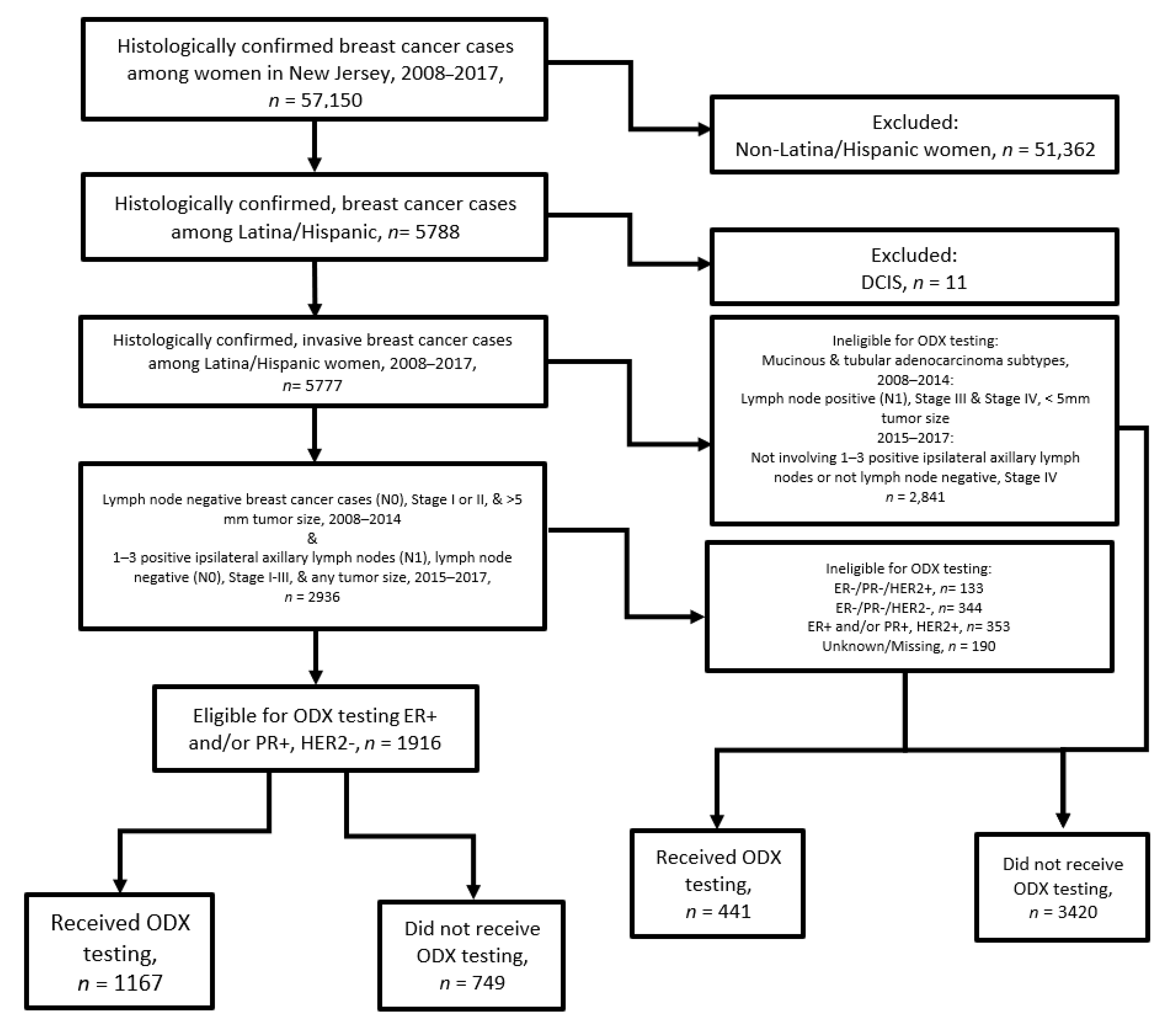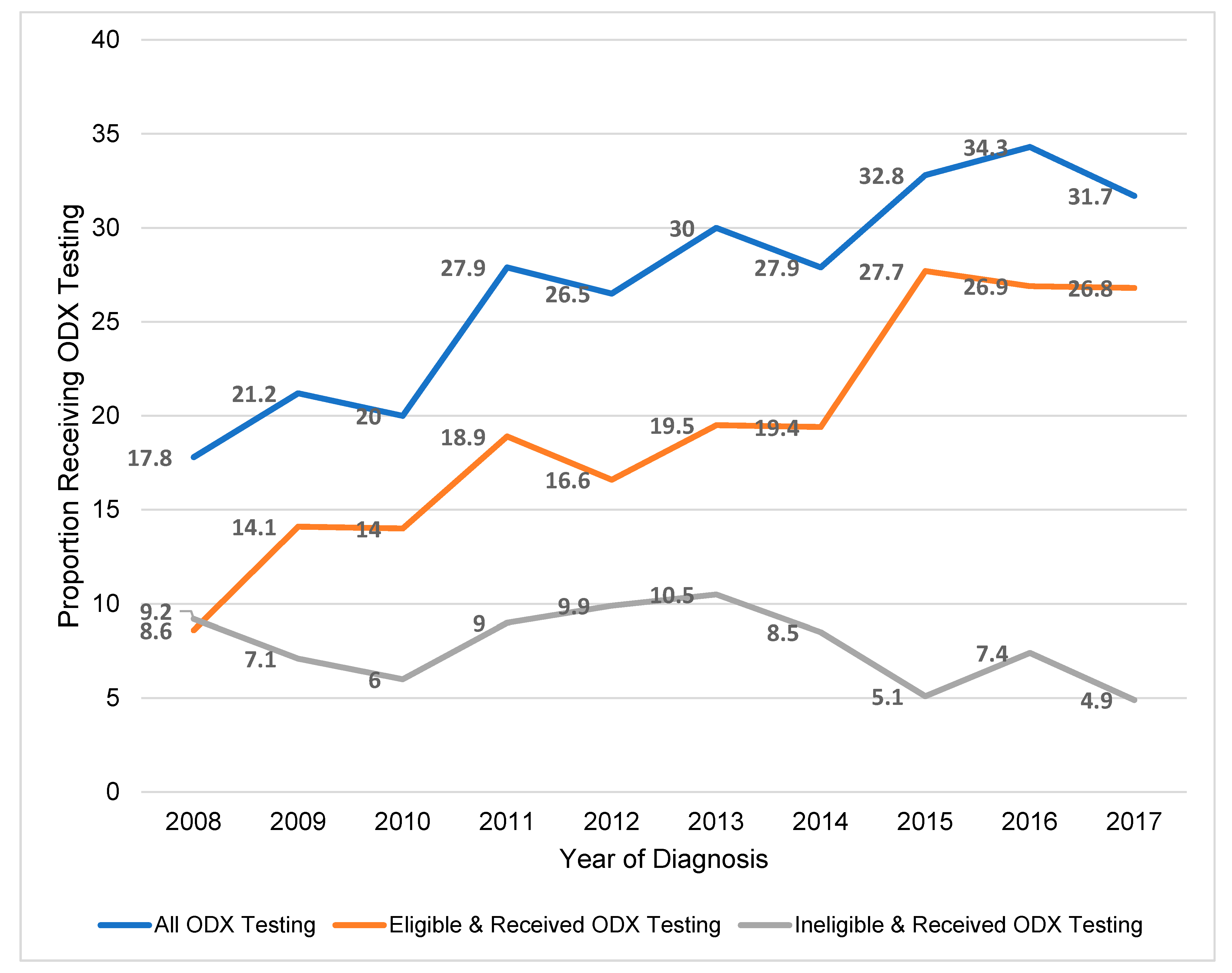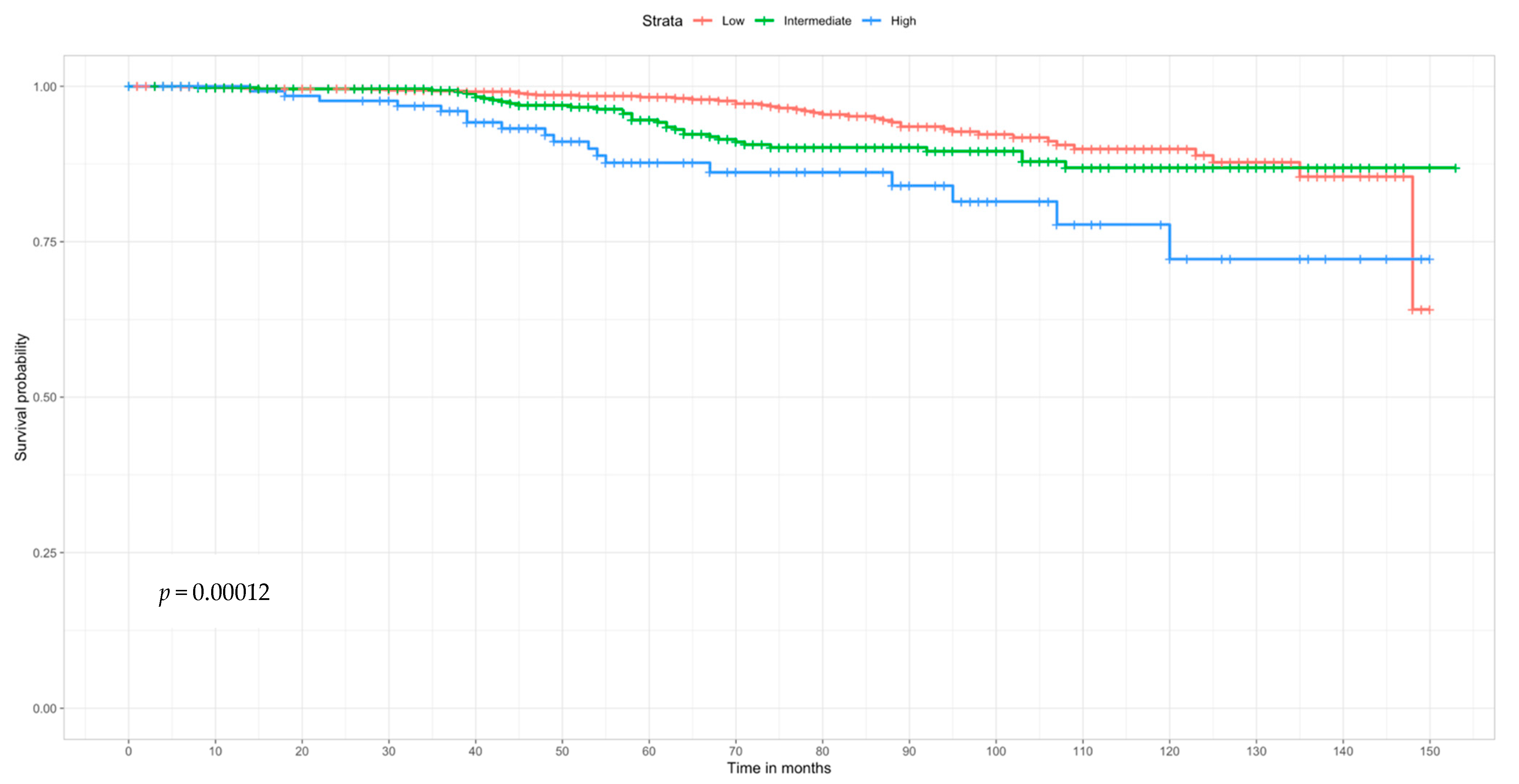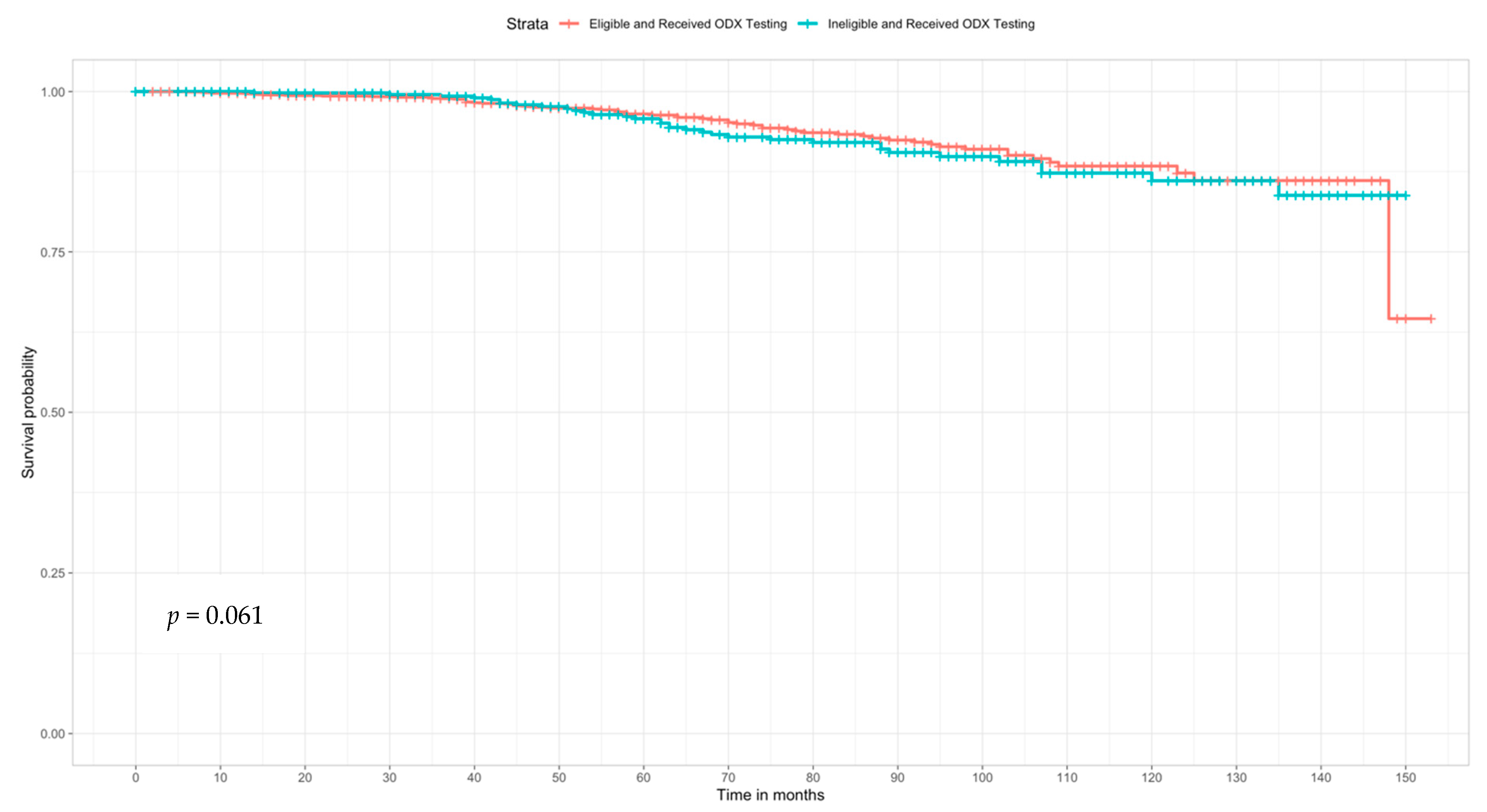Oncotype DX Test Receipt among Latina/Hispanic Women with Early Invasive Breast Cancer in New Jersey: A Registry-Based Study
Abstract
1. Introduction
2. Methods
2.1. Study Population and Data Collection
2.2. Categorization of Sociodemographic Characteristics
2.3. Clinicopathological Variables
2.4. Oncotype DX (ODX) Test Eligibility
2.5. Statistical Analysis
3. Results
4. Discussion
5. Conclusions
Supplementary Materials
Author Contributions
Funding
Institutional Review Board Statement
Informed Consent Statement
Data Availability Statement
Acknowledgments
Conflicts of Interest
References
- Siegel, R.L.; Miller, K.D.; Fuchs, H.E.; Jemal, A. Cancer Statistics, 2021. CA Cancer J. Clin. 2021, 71, 7–33. [Google Scholar] [CrossRef]
- Burger, S. Five Leading Sites of New Cancer Deaths: Rates by Gender, Race and Ethnicity, 2012–2016; New Jersey Department of Health. 2018. Available online: https://www.nj.gov/health/ces/documents/briefs/top5_ca_mortality_byrace_eth_annualreportexcerpt_12-16.pdf (accessed on 3 March 2020).
- Bucca, G.; Carruba, G.; Saetta, A.; Muti, P.; Castagnetta, L.; Smith, C.P. Gene Expression Profiling of Human Cancers. Ann. N. Y. Acad. Sci. 2004, 1028, 28–37. [Google Scholar] [CrossRef] [PubMed]
- Petkov, V.I.; Miller, D.P.; Howlader, N.; Gliner, N.; Howe, W.; Schussler, N.; Cronin, K.; Baehner, F.L.; Cress, R.; Deapen, D.; et al. Breast-cancer-specific mortality in patients treated based on the 21-gene assay: A SEER population-based study. NPJ Breast Cancer 2016, 2, 16017. [Google Scholar] [CrossRef]
- Jamieson, N.B.; Maker, A.V. Gene-expression profiling to predict responsiveness to immunotherapy. Cancer Gene Ther. 2017, 24, 134–140. [Google Scholar] [CrossRef]
- Loncaster, J.; Armstrong, A.; Howell, S.; Wilson, G.; Welch, R.; Chittalia, A.; Valentine, W.; Bundred, N. Impact of Oncotype DX breast Recurrence Score testing on adjuvant chemotherapy use in early breast cancer: Real world experience in Greater Manchester, UK. Eur. J. Surg. Oncol. (EJSO) 2017, 43, 931–937. [Google Scholar] [CrossRef] [PubMed]
- Marchionni, L.; Wilson, R.F.; Marinopoulos, S.S.; Wolff, A.C.; Parmigiani, G.; Bass, E.B.; Goodman, S.N. Impact of Gene Ex-pression Profiling Tests on Breast Cancer Outcomes. Evidence Report/Technology Assessment, 2008, 1–105. Available online: https://www.ahrq.gov/downloads/pub/evidence/pdf/brcancergene/brcangene.pdf (accessed on 26 February 2020).
- Kozick, Z.; Hashmi, A.; Dove, J.; Hunsinger, M.; Arora, T.; Wild, J.; Shabahang, M.; Blansfield, J. Disparities in compliance with the Oncotype DX breast cancer test in the United States: A National Cancer Data Base assessment. Am. J. Surg. 2018, 215, 686–692. [Google Scholar] [CrossRef] [PubMed]
- Zhang, L.; Hsieh, M.-C.; Petkov, V.; Yu, Q.; Chiu, Y.-W.; Wu, X.-C. Trend and survival benefit of Oncotype DX use among female hormone receptor-positive breast cancer patients in 17 SEER registries, 2004–2015. Breast Cancer Res. Treat. 2020, 180, 491–501. [Google Scholar] [CrossRef]
- Davis, B.A.; Aminawung, J.A.; Abu-Khalaf, M.M.; Evans, S.B.; Su, K.; Mehta, R.; Wang, S.-Y.; Gross, C.P. Racial and Ethnic Disparities in Oncotype DX Test Receipt in a Statewide Population-Based Study. J. Natl. Compr. Cancer Netw. 2017, 15, 346–354. [Google Scholar] [CrossRef]
- Hoskins, K.F.; Danciu, O.C.; Ko, N.Y.; Calip, G.S. Association of Race/Ethnicity and the 21-Gene Recurrence Score With Breast Cancer–Specific Mortality Among US Women. JAMA Oncol. 2021, 7, 370. [Google Scholar] [CrossRef]
- Mph, K.D.M.; Sauer, A.G.; Ortiz, A.P.; Fedewa, S.A.; Pinheiro, P.S.; Tortolero-Luna, G.; Martinez-Tyson, D.; Jemal, A.; Siegel, R.L. Cancer Statistics for Hispanics/Latinos, 2018. CA Cancer J. Clin. 2018, 68, 425–445. [Google Scholar] [CrossRef]
- Cress, R.D.; Chen, Y.S.; Morris, C.R.; Chew, H.; Kizer, K.W. Underutilization of gene expression profiling for early-stage breast cancer in California. Cancer Causes Control. 2016, 27, 721–727. [Google Scholar] [CrossRef] [PubMed]
- Bargallo, J.E.; Lara, F.; Shaw-Dulin, R.; Perez-Sánchez, V.; Villarreal-Garza, C.; Maldonado-Martinez, H.; Mohar-Betancourt, A.; Yoshizawa, C.; Burke, E.; Decker, T.; et al. A study of the impact of the 21-gene breast cancer assay on the use of adjuvant chemotherapy in women with breast cancer in a Mexican public hospital. J. Surg. Oncol. 2014, 111, 203–207. [Google Scholar] [CrossRef]
- Maly, R.C.; Stein, J.A.; Umezawa, Y.; Leake, B.; Anglin, M.D. Racial/ethnic differences in breast cancer outcomes among older patients: Effects of physician communication and patient empowerment. Heal. Psychol. 2008, 27, 728–736. [Google Scholar] [CrossRef] [PubMed]
- Frieden, T.R.; Centers for Disease, C. Prevention CDC Health Disparities and Inequalities Report—United States, 2013. Foreword. MMWR Suppl. 2013, 62, 1–2. Available online: https://www.cdc.gov/mmwr/pdf/other/su6203.pdf (accessed on 26 February 2020). [PubMed]
- Marcinkowski, E.F.; Ottesen, R.; Niland, J.; Vito, C. Acceptance of adjuvant chemotherapy recommendations in early-stage hormone-positive breast cancer. J. Surg. Res. 2017, 214, 79–85. [Google Scholar] [CrossRef]
- Valdeón, R.A. The use of Latin American, Hispanic and Latino in US academic articles, 2000–2010. Terminol. Int. J. Theor. Appl. Issues Spec. Commun. 2013, 19, 112–137. [Google Scholar] [CrossRef]
- Hayes-Bautista, D.E.; Chapa, J. Latino terminology: Conceptual bases for standardized terminology. Am. J. Public Health 1987, 77, 61–68. [Google Scholar] [CrossRef]
- NAACCR Race and Ethnicity Work Group NAACCR Guideline for Enhancing Hispanic/Latino Identification: Revised NAACCR Hispanic/Latino Identification Algorithm [NHIA v2.2.1]; North American Association of Central Cancer Registries: Springfield (IL). 2011. Available online: https://www.naaccr.org/wp-content/uploads/2016/11/NHIA-v2.2.1.pdf (accessed on 2 February 2020).
- National Cancer Institute. Race Recode Changes. USA. Available online: https://seer.cancer.gov/seerstat/variables/seer/yr1973_2003/race_ethnicity/ (accessed on 24 October 2020).
- National Cancer Institute. Insurance Recode (2007+), USA. Available online: https://seer.cancer.gov/seerstat/variables/seer/insurance-recode/ (accessed on 24 October 2020).
- Yu, M.; Tatalovich, Z.; Gibson, J.T.; Cronin, K.A. Using a composite index of socioeconomic status to investigate health disparities while protecting the confidentiality of cancer registry data. Cancer Causes Control. 2013, 25, 81–92. [Google Scholar] [CrossRef]
- Yost, K.; Perkins, C.; Cohen, R.; Morris, C.; Wright, W. Socioeconomic status and breast cancer incidence in California for different race/ethnic groups. Cancer Causes Control. 2001, 12, 703–711. [Google Scholar] [CrossRef] [PubMed]
- Liu, L.; Deapen, D.; Bernstein, L. Socioeconomic status and cancers of the female breast and reproductive organs: A comparison across racial/ethnic populations in Los Angeles County, California (United States). Cancer Causes Control. 1998, 9, 369–380. [Google Scholar] [CrossRef]
- Kulkarni, A.; Stroup, A.M.; Paddock, L.E.; Hill, S.M.; Plascak, J.J.; Llanos, A.A. Breast Cancer Incidence and Mortality by Molecular Subtype: Statewide Age and Racial/Ethnic Disparities in New Jersey. Cancer Health Disparities 2019, 3, e1–e17. [Google Scholar]
- Press, D.J.; Ibraheem, A.; Dolan, M.E.; Goss, K.H.; Conzen, S.; Huo, D. Racial disparities in omission of oncotype DX but no racial disparities in chemotherapy receipt following completed oncotype DX test results. Breast Cancer Res. Treat. 2017, 168, 207–220. [Google Scholar] [CrossRef] [PubMed]
- Orucevic, A.; Heidel, R.E.; Bell, J.L. Utilization and impact of 21-gene recurrence score assay for breast cancer in clinical practice across the United States: Lessons learned from the 2010 to 2012 National Cancer Data Base analysis. Breast Cancer Res. Treat. 2016, 157, 427–435. [Google Scholar] [CrossRef]
- Trosman, J.R.; Van Bebber, S.L.; Phillips, K.A. Coverage Policy Development for Personalized Medicine: Private Payer Perspectives on Developing Policy for the 21-Gene Assay. J. Oncol. Pr. 2010, 6, 238–242. [Google Scholar] [CrossRef] [PubMed]
- Lynch, J.A.; Berse, B.; Coomer, N.; Kautter, J. 21-Gene recurrence score testing among Medicare beneficiaries with breast cancer in 2010–2013. Genet. Med. 2017, 19, 1134–1143. [Google Scholar] [CrossRef] [PubMed]
- Jahn, B.; Rochau, U.; Kurzthaler, C.; Hubalek, M.; Miksad, R.; Sroczynski, G.; Paulden, M.; Bundo, M.; Stenehjem, D.; Brixner, D.; et al. Personalized treatment of women with early breast cancer: A risk-group specific cost-effectiveness analysis of adjuvant chemotherapy accounting for companion prognostic tests OncotypeDX and Adjuvant!Online. BMC Cancer 2017, 17, 685. [Google Scholar] [CrossRef]
- Sparano, J.A. TAILORx: Trial Assigning Individualized Options for Treatment (Rx). Clin. Breast Cancer 2006, 7, 347–350. [Google Scholar] [CrossRef] [PubMed]
- Schwedhelm, T.M.; Rees, J.R.; Onega, T.; Zipkin, R.J.; Schaefer, A.; Celaya, M.O.; Moen, E.L. Patient and physician factors associated with Oncotype DX and adjuvant chemotherapy utilization for breast cancer patients in New Hampshire, 2010–2016. BMC Cancer 2020, 20, 1–13. [Google Scholar] [CrossRef]
- Centers for Medicare and Medicaid Services 2015 Clinical Diagnostic Laboratory Fee Schedule. Available online: https://www.cms.gov/Medicare/Medicare-Fee-for-Service-Payment/ClinicalLabFeeSched/Clinical-Laboratory-Fee-Schedule-Files (accessed on 26 February 2020).
- Kizy, S.; Altman, A.M.; Marmor, S.; Denbo, J.W.; Jensen, E.H.; Tuttle, T.M.; Hui, J.Y.C. 21-gene recurrence score testing in the older population with estrogen receptor-positive breast cancer. J. Geriatr. Oncol. 2019, 10, 322–329. [Google Scholar] [CrossRef] [PubMed]
- Dinan, M.A.; Mi, X.; Reed, S.D.; Hirsch, B.R.; Lyman, G.H.; Curtis, L.H. Initial Trends in the Use of the 21-Gene Recurrence Score Assay for Patients With Breast Cancer in the Medicare Population, 2005-2009. JAMA Oncol. 2015, 1, 158–166. [Google Scholar] [CrossRef]
- Early Breast Cancer Trialists’ Collaborative Group (EBCTCG) Comparisons between different polychemotherapy regimens for early breast cancer: Meta-analyses of long-term outcome among 100 000 women in 123 randomised trials. Lancet 2012, 379, 432–444. [CrossRef]
- Setiawan, V.W.; Wei, P.C.; Hernandez, B.Y.; Lu, S.C.; Monroe, K.R.; Le Marchand, L.; Yuan, J.M. Disparity in liver cancer incidence and chronic liver disease mortality by nativity in Hispanics: The Multiethnic Cohort. Cancer 2016, 122, 1444–1452. [Google Scholar] [CrossRef] [PubMed]
- Keegan, T.H.; John, E.M.; Fish, K.M.; Alfaro-Velcamp, T.; Clarke, C.A.; Gomez, S.L. Breast Cancer Incidence Patterns among California Hispanic Women: Differences by Nativity and Residence in an Enclave. Cancer Epidemiol. Biomarkers Prev. 2010, 19, 1208–1218. [Google Scholar] [CrossRef] [PubMed]
- Pinheiro, P.S.; Callahan, K.E.; Gomez, S.L.; Marcos-Gragera, R.; Cobb, T.R.; Roca-Barcelo, A.; Ramirez, A.G. High cancer mortality for US-born Latinos: Evidence from California and Texas. BMC Cancer 2017, 17, 1–13. [Google Scholar] [CrossRef] [PubMed]
- Rodríguez, M.A.; Ward, L.M.; Pérez-Stable, E.J. Breast and Cervical Cancer Screening: Impact of Health Insurance Status, Ethnicity, and Nativity of Latinas. Ann. Fam. Med. 2005, 3, 235–241. [Google Scholar] [CrossRef]
- Chang, E.T.; Gomez, S.L.; Fish, K.; Schupp, C.W.; Parsonnet, J.; DeRouen, M.C.; Keegan, T.H.M.; Clarke, C.A.; Glaser, S.L. Gastric Cancer Incidence among Hispanics in California: Patterns by Time, Nativity, and Neighborhood Characteristics. Cancer Epidemiol. Biomarkers Prev. 2012, 21, 709–719. [Google Scholar] [CrossRef]
- Ramirez, A.G.; Trapido, E.J. A Way Forward: The Future of Cancer Health Disparities Research in Latinos. In Advancing the Science of Cancer in Latinos; Metzler, J.B., Ed.; Springer: Cham, Switzerland, 2019; pp. 225–232. [Google Scholar]
- Gonzalez-Barrera, A.; Lopez, M.H.A. Demographic Portrait of Mexican-Origin Hispanics in the United States; Pew Hispanic Center: Washington, DC, USA, 2013; Available online: https://www.pewresearch.org/hispanic/2013/05/01/a-demographic-portrait-of-mexican-origin-hispanics-in-the-united-states/ (accessed on 24 August 2020).
- Pinheiro, P.S.; Callahan, K.E.; Kobetz, E.N. Disaggregated Hispanic Groups and Cancer: Importance, Methodology, and Current Knowledge. In Advancing the Science of Cancer in Latinos; Metzler, J.B., Ed.; Springer: Cham, Switzerland, 2019; pp. 17–34. [Google Scholar]
- Sparano, J.A.; Gray, R.J.; Makower, D.F.; Pritchard, K.I.; Albain, K.S.; Hayes, D.F.; Geyer, C.E.; Dees, E.C.; Perez, E.A.; Olson, J.A.; et al. Prospective Validation of a 21-Gene Expression Assay in Breast Cancer. N. Engl. J. Med. 2015, 373, 2005–2014. [Google Scholar] [CrossRef]
- Sparano, J.A.; Paik, S. Development of the 21-Gene Assay and Its Application in Clinical Practice and Clinical Trials. J. Clin. Oncol. 2008, 26, 721–728. [Google Scholar] [CrossRef]
- Hill, S.; Katz, H.; Stroup, A. Innovative Sources for Breast Cancer: Supplementing Registry Multigene Assay Data through Linkages. In Proceedings of the NAACCR Annual Conference, Pittsburgh, PA, USA, 14 June 2018; Available online: https://www.naaccr.org/wp-content/uploads/2018/06/2018-NAACCR-Final-Abstract-Program.pdf (accessed on 1 March 2020).
- Latinos in the 2016 Election: New Jersey; Hispanic Trends; Pew Research Center: Washington, DC, USA; Available online: https://www.pewresearch.org/hispanic/fact-sheet/latinos-in-the-2016-election-new-jersey/ (accessed on 22 August 2020).
- Roberts, M.C.; Weinberger, M.; Dusetzina, S.B.; Dinan, M.A.; Reeder-Hayes, K.E.; Carey, L.A.; Troester, M.A.; Wheeler, S.B. Racial Variation in the Uptake of Oncotype DX Testing for Early-Stage Breast Cancer. J. Clin. Oncol. 2016, 34, 130–138. [Google Scholar] [CrossRef]




| Received ODX Test (n = 1167) | Did Not Receive ODX Test (n = 749) | p | |
|---|---|---|---|
| Sociodemographic characteristics | |||
| Age at Diagnosis, y | <0.001 | ||
| Mean ± SD | 56.33 ± 11.22 | 58.59 ± 13.71 | |
| Range | 24.0–88.0 | 20.0–91.0 | |
| Age at Diagnosis | <0.001 | ||
| <50 | 360 (30.8) | 214 (28.6) | |
| 50–59 | 343 (29.4) | 182 (24.3) | |
| 60–69 | 299 (25.6) | 164 (21.9) | |
| 70–79 | 156 (13.4) | 151 (20.1) | |
| ≥80 | 9 (0.8) | 38 (5.1) | |
| Race | 0.829 | ||
| White | 1046 (89.6) | 681 (90.9) | |
| Black | 53 (4.6) | 32 (4.3) | |
| Other a | 62 (5.3) | 36 (4.8) | |
| Missing/Unknown | 6 (0.5) | 0 (0) | |
| Ethnic Subgroup b | 0.284 | ||
| Mexican | 44 (3.8) | 32 (4.3) | |
| Puerto Rican | 192 (16.5) | 144 (19.2) | |
| Cuban | 67 (5.7) | 32 (4.3) | |
| South or Central American | 223 (19.1) | 160 (21.3) | |
| Spanish/Hispanic/Latino NOS | 361 (30.9) | 212 (28.3) | |
| Dominican | 59 (5.1) | 41 (5.5) | |
| Other | 221 (18.9) | 128 (17.1) | |
| Nativity | 0.312 | ||
| U.S. Born | 139 (11.9) | 79 (10.6) | |
| Non-US-born | 424 (36.3) | 287 (38.3) | |
| Unknown/Missing | 604 (51.8) | 383 (51.1) | |
| Insurance | 0.018 | ||
| Insured | 740 (63.4) | 440 (58.7) | |
| Medicaid | 178 (15.3) | 107 (14.3) | |
| Uninsured | 77 (6.6) | 77 (10.3) | |
| Insured, but Not Specified | 140 (12.0) | 98 (13.1) | |
| Missing/Unknown | 32 (2.7) | 27(3.6) | |
| Area-Based Composite Socioeconomic Status c | 0.001 | ||
| Low | 196 (16.8) | 169 (22.5) | |
| Low-middle | 219 (18.7) | 140 (18.7) | |
| Middle | 198 (17.0) | 125 (16.7) | |
| Middle-high | 239 (20.5) | 160 (21.4) | |
| High | 299 (25.6) | 149 (19.9) | |
| Unknown/Missing | 16 (1.4) | 6 (0.8) | |
| Clinical characteristics | |||
| Histologic Type | 0.446 | ||
| Ductal | 886 (75.9) | 556 (74.2) | |
| Lobular | 118 (10.1) | 69 (9.2) | |
| Both Lobular and Ductal | 91 (7.8) | 62 (8.3) | |
| Mixed | 44 (3.8) | 36 (4.8) | |
| Other/Unknown | 28 (2.4) | 26 (3.5) | |
| Tumor Stage | <0.001 | ||
| Stage I | 849 (72.8) | 444 (59.3) | |
| Stage II | 312 (26.7) | 283 (37.8) | |
| Stage III | 6 (0.5) | 22 (2.9) | |
| Tumor Grade | <0.001 | ||
| Well Differentiated | 211 (18.1) | 150 (20.0) | |
| Moderately Differentiated | 702 (60.2) | 358 (47.8) | |
| Poorly Differentiated d | 213 (18.2) | 203 (27.1) | |
| Missing/Unknown | 41 (3.5) | 38 (5.1) | |
| Tumor Size | <0.001 | ||
| ≤5 mm | 27 (2.3) | 79 (10.5) | |
| >5–10 mm | 294 (25.2) | 157 (21.0) | |
| >10–20 mm | 574 (49.2) | 267 (35.6) | |
| >20–40 mm | 243 (20.8) | 187 (25.0) | |
| >40 mm | 29 (2.5) | 59 (7.9) | |
| Tumor Subtype | <0.001 | ||
| ER−/PR+/HER2− | 2 (0.2) | 24 (3.2) | |
| ER+/PR−/HER2− | 103 (8.8) | 106 (14.2) | |
| ER+/PR+/HER2− | 1062 (91.0) | 619 (82.6) | |
| Reported Chemotherapy | <0.001 | ||
| Yes | 276 (23.7) | 295 (39.4) | |
| No | 852 (73.0) | 425 (56.7) | |
| Unknown | 39 (3.3) | 29 (3.9) |
| Variable | Received ODX Test (n = 1608) | Eligible & Received (n = 1167) | Ineligible & Received (n = 441) | p |
|---|---|---|---|---|
| Oncotype DX Recurrence Score | ||||
| Mean ± SD | 17.09 ± 9.69 | 16.50 ± 8.98 | 18.63 ± 11.23 | <0.001 |
| Range | 0–63.0 | 0–63.0 | 0–62.0 | |
| Oncotype DX Risk Group a | ||||
| Low Risk | 565 (54.5) | 737 (63.2) | 253 (57.4) | <0.001 |
| Intermediate Risk | 277 (26.7) | 353 (30.2) | 130 (29.5) | |
| High Risk | 83 (8.0) | 77 (6.6) | 58 (13.2) |
| Unadjusted OR | Adjusted OR a | |||||
|---|---|---|---|---|---|---|
| Covariate | OR | 95% CI | ptrend | AOR | 95% CI | ptrend |
| Age at Diagnosis | ||||||
| <50 | 1.00 | (Ref) | <0.001 | 1.00 | (Ref) | <0.001 |
| 50–59 | 1.12 | 0.88, 1.43 | 0.97 | 0.73, 1.28 | ||
| 60–69 | 1.08 | 0.84, 1.40 | 0.89 | 0.67, 1.19 | ||
| 70–79 | 0.61 | 0.46, 0.81 | 0.43 | 0.31, 0.59 | ||
| ≥80 | 0.14 | 0.07, 0.30 | 0.08 | 0.04, 0.18 | ||
| Ethnic Subgroup | ||||||
| Spanish/Hispanic/Latino NOS | 1.00 | (Ref) | 1.00 | (Ref) | ||
| Cuban | 1.23 | 0.78, 1.94 | 1.60 | 0.95, 2.70 | ||
| Dominican | 0.85 | 0.55, 1.30 | 0.97 | 0.60, 1.57 | ||
| Mexican | 0.81 | 0.50, 1.31 | 0.82 | 0.47, 1.44 | ||
| Other | 1.01 | 0.77, 1.34 | 0.87 | 0.63, 1.19 | ||
| Puerto Rican | 0.78 | 0.59, 1.03 | 0.76 | 0.55, 1.04 | ||
| South or Central American | 0.82 | 0.63, 1.07 | 0.93 | 0.69, 1.26 | ||
| Insurance | ||||||
| Insured | 1.00 | (Ref) | 1.00 | (Ref) | ||
| Insured, NOS | 0.85 | 0.64, 1.13 | 0.92 | 0.67, 1.27 | ||
| Medicaid | 0.99 | 0.76, 1.29 | 1.32 | 0.97, 1.81 | ||
| Uninsured | 0.59 | 0.42, 0.83 | 0.58 | 0.39, 0.86 | ||
| Area-Based Composite Socioeconomic Status | ||||||
| High | 1.00 | (Ref) | 0.329 | 1.00 | (Ref) | 0.472 |
| Middle–High | 0.74 | 0.56, 0.99 | 0.76 | 0.56, 1.05 | ||
| Middle | 0.79 | 0.59, 1.06 | 0.77 | 0.55, 1.08 | ||
| Low–Middle | 0.78 | 0.58, 1.04 | 0.82 | 0.59, 1.14 | ||
| Low | 0.58 | 0.43, 0.77 | 0.58 | 0.42, 0.82 | ||
| Tumor Stage | ||||||
| Stage I | 1.00 | (Ref) | 1.00 | (Ref) | ||
| Stage II | 0.58 | 0.47, 0.70 | 0.34 | 0.22, 0.54 | ||
| Stage III | 0.14 | 0.06, 0.35 | 0.06 | 0.02, 0.22 | ||
| Tumor Grade | ||||||
| Well Differentiated | 1.00 | (Ref) | 1.00 | (Ref) | ||
| Moderately Differentiated | 1.39 | 1.09, 1.78 | 1.61 | 1.22, 2.13 | ||
| Poorly Differentiated | 0.75 | 0.56, 0.99 | 0.82 | 0.59, 1.12 | ||
| Tumor Size | ||||||
| ≤5 mm | 1.00 | (Ref) | <0.001 | 1.00 | (Ref) | <0.001 |
| >5–10 mm | 5.48 | 3.40, 8.84 | 6.03 | 3.61, 10.09 | ||
| >10–20 mm | 6.29 | 3.97, 9.97 | 7.64 | 4.64, 12.56 | ||
| >20–40 mm | 3.80 | 2.36, 6.12 | 12.30 | 6.27, 24.03 | ||
| >40 mm | 1.44 | 0.77, 2.68 | 5.24 | 2.31, 11.89 | ||
Publisher’s Note: MDPI stays neutral with regard to jurisdictional claims in published maps and institutional affiliations. |
© 2021 by the authors. Licensee MDPI, Basel, Switzerland. This article is an open access article distributed under the terms and conditions of the Creative Commons Attribution (CC BY) license (https://creativecommons.org/licenses/by/4.0/).
Share and Cite
Acuna, N.; Plascak, J.J.; Tsui, J.; Stroup, A.M.; Llanos, A.A.M. Oncotype DX Test Receipt among Latina/Hispanic Women with Early Invasive Breast Cancer in New Jersey: A Registry-Based Study. Int. J. Environ. Res. Public Health 2021, 18, 5116. https://doi.org/10.3390/ijerph18105116
Acuna N, Plascak JJ, Tsui J, Stroup AM, Llanos AAM. Oncotype DX Test Receipt among Latina/Hispanic Women with Early Invasive Breast Cancer in New Jersey: A Registry-Based Study. International Journal of Environmental Research and Public Health. 2021; 18(10):5116. https://doi.org/10.3390/ijerph18105116
Chicago/Turabian StyleAcuna, Nicholas, Jesse J. Plascak, Jennifer Tsui, Antoinette M. Stroup, and Adana A. M. Llanos. 2021. "Oncotype DX Test Receipt among Latina/Hispanic Women with Early Invasive Breast Cancer in New Jersey: A Registry-Based Study" International Journal of Environmental Research and Public Health 18, no. 10: 5116. https://doi.org/10.3390/ijerph18105116
APA StyleAcuna, N., Plascak, J. J., Tsui, J., Stroup, A. M., & Llanos, A. A. M. (2021). Oncotype DX Test Receipt among Latina/Hispanic Women with Early Invasive Breast Cancer in New Jersey: A Registry-Based Study. International Journal of Environmental Research and Public Health, 18(10), 5116. https://doi.org/10.3390/ijerph18105116







